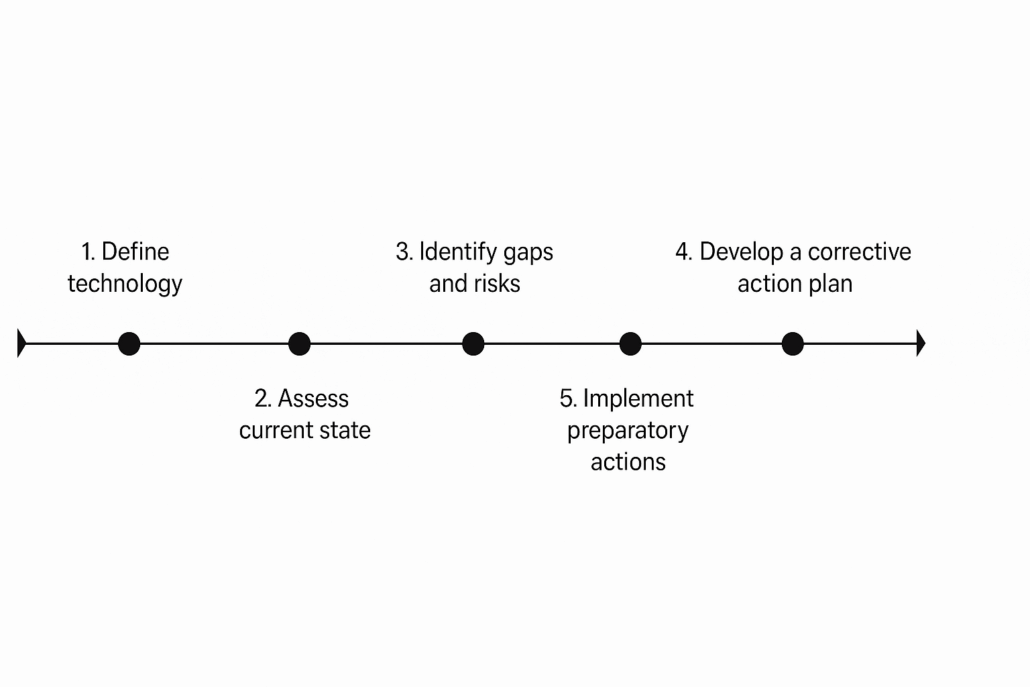
In the publication “Intelligent Agents in AI Really Can Work Alone. Here’s How.” by Gartner, the authors predict that by 2028, 33% of business applications will use agentic artificial intelligence, compared to less than 1% in 2024. This development will enable autonomous decision-making for up to 15% of daily operational tasks. Is your company prepared to take advantage of these changes?
Technological readiness is a broad concept that encompasses IT infrastructure, team capabilities, the maturity of business processes, organizational readiness for change, and compliance with legal and security policies. Companies planning to implement ERP systems, identity and access management (IAM) tools, or AI-based solutions need a strong technical and operational foundation to succeed.
How to Assess an Enterprise’s Technological Readiness?
To accurately determine an enterprise’s technological readiness, it’s worth conducting an assessment across several key areas. This process is similar to an audit, helping to answer a crucial question: is the company prepared to successfully implement and make use of a new technology?
IT Infrastructure
The assessment of IT infrastructure should begin with a clear definition of the requirements of the new technology. These requirements determine which resources will be necessary — in terms of performance, architecture, security, and availability.
Only once you have a clear technological specification can you reliably assess whether your current IT environment is capable of meeting those requirements. If you’re considering introducing AI-based tools into your organization and want to understand the exact costs associated with deploying and maintaining a large language model, be sure to check out our latest analysis.
Managing and Accessing Data
The assessment of data management should begin by identifying what data will be used by the new technology, in what format, how frequently, and from which sources. It’s the system’s requirements that define what data is needed and in what form it must be available.
Only based on this can you determine whether the data within the organization is ready for use. It’s essential to verify whether there are technical means for retrieving data from sources (e.g., APIs, data exchange files), whether the data has a consistent structure, and whether it meets minimum quality standards. Inconsistencies, duplicates, incomplete records, or unstructured data may require an additional processing stage before the data can be effectively used.
Organizational accessibility is equally important — data must be available not only technically, but also in accordance with internal policies and regulations. For sensitive data, it’s crucial to ensure that access complies with security policies and legal frameworks such as the GDPR.
If the planned technology involves integration of multiple sources, real-time analysis, or processing of large volumes of data, it may be necessary to prepare a dedicated integration layer or reorganize the company’s data management approach.
Team Preparation and Training
Assessing team readiness should start with an analysis of the competencies required to operate the new technology. Depending on the solution, this may involve both technical skills (e.g., system configuration, data analysis) and operational knowledge (e.g., understanding business processes, interpreting system outputs).
Only once roles and responsibilities in the new environment are clearly defined can you assess whether the team has the necessary qualifications or if additional training is needed. This might involve upskilling through training sessions, involving external experts, or securing temporary support from the technology provider.
Special attention should be given to those responsible for maintaining and developing the system — they need early access to information about the architecture, data model, failure scenarios, and access controls. Without this, the new technology risks becoming a “black box,” increasing the likelihood of operational errors and making future improvements more difficult.
Team preparation should not be a one-time effort. It’s important to plan for post-implementation activities such as mentoring, internal documentation, and continuous development of skills in areas supported by the new technology.
Measuring Business Readiness
Assessing technological readiness should be treated as a process. The most effective approach is to create a roadmap of preparatory actions and then measure progress based on clearly defined stages and evaluation criteria.

The roadmap should include key areas such as IT infrastructure, data availability, team readiness, system integration, change management, and regulatory compliance. For each of these areas, it’s important to define the target requirements as well as assess the current state. This approach not only helps estimate the overall level of readiness but also identifies specific obstacles and weak points that may hinder the implementation process.
Step-by-step evaluation — based on the schedule and tasks assigned to specific teams — allows for ongoing verification of whether the company is moving toward operational readiness. This approach helps minimize the risk of unexpected delays and costs, as potential issues can be detected early, before entering the actual implementation phase.
Technological readiness is not a single end result. It’s the sum of many elements — technical, organizational, and competency-related — all of which should be assessed in the context of the specific implementation and its requirements.
How We Work
When working with clients on the implementation of new applications and systems, we always begin by discussing the business context and the organization’s actual needs. We don’t recommend off-the-shelf solutions without prior analysis — instead, we help identify which technologies have the potential to truly improve processes, and which may only lead to unnecessary costs and complications.
Drawing on our experience from IT projects across various industries, we provide step-by-step guidance — from the planning stage, through readiness assessment, to proper implementation and stabilization. We make sure the technology fits the organization’s capabilities and genuinely supports its operational development, rather than becoming an additional burden.
A well-planned implementation doesn’t end with launching an application — it ends with achieving the intended business outcomes.

